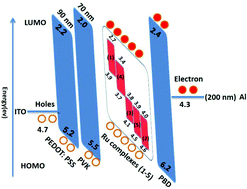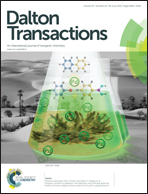Red electroluminescence of ruthenium sensitizer functionalized by sulfonate anchoring groups†
Abstract
We have synthesized five novel Ru(II) phenanthroline complexes with an additional aryl sulfonate ligating substituent at the 5-position [Ru(L)(bpy)2](BF4)2 (1), [Ru(L)(bpy)(SCN)2] (2), [Ru(L)3](BF4)2 (3), [Ru(L)2(bpy)](BF4)2 (4) and [Ru(L)(BPhen)(SCN)2] (5) (where L = 6-one-[1,10]phenanthroline-5-ylamino)-3-hydroxynaphthalene 1-sulfonic, bpy = 2,2′-bipyridine, BPhen = 4,7-diphenyl-1,10-phenanthroline), as both photosensitizers for oxide semiconductor solar cells (DSSCs) and light emitting diodes (LEDs). The absorption and emission maxima of these complexes red shifted upon extending the conjugation of the phenanthroline ligand. Ru phenanthroline complexes exhibit broad metal to ligand charge transfer-centered electroluminescence (EL) with a maximum near 580 nm. Our results indicated that a particular structure (2) can be considered as both DSSC and OLED devices. The efficiency of the LED performance can be tuned by using a range of ligands. Device (2) has a luminance of 550 cd m−2 and maximum efficiency of 0.9 cd A−1 at 18 V, which are the highest values among the five devices. The turn-on voltage of this device is approximately 5 V. The role of auxiliary ligands in the photophysical properties of Ru complexes was investigated by DFT calculation. We have also studied photovoltaic properties of dye-sensitized nanocrystalline semiconductor solar cells based on Ru phenanthroline complexes and an iodine redox electrolyte. A solar energy to electricity conversion efficiency (η) of 0.67% was obtained for Ru complex (2) under standard AM 1.5 irradiation with a short-circuit photocurrent density (Jsc) of 2.46 mA cm−2, an open-circuit photovoltage (Voc) of 0.6 V, and a fill factor (ff) of 40%, which are all among the highest values for ruthenium sulfonated anchoring groups reported so far. Monochromatic incident photon to current conversion efficiency was 23% at 475 nm. Photovoltaic studies clearly indicated dyes with two SCN substituents yielded a higher Jsc for the cell than dyes with a tris-homoleptic anchor substituent.


 Please wait while we load your content...
Please wait while we load your content...